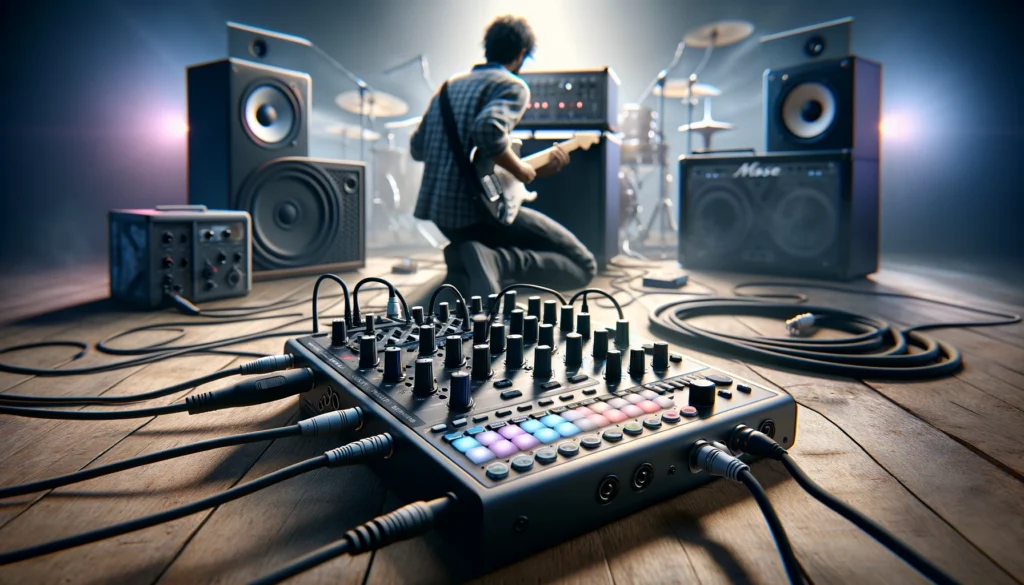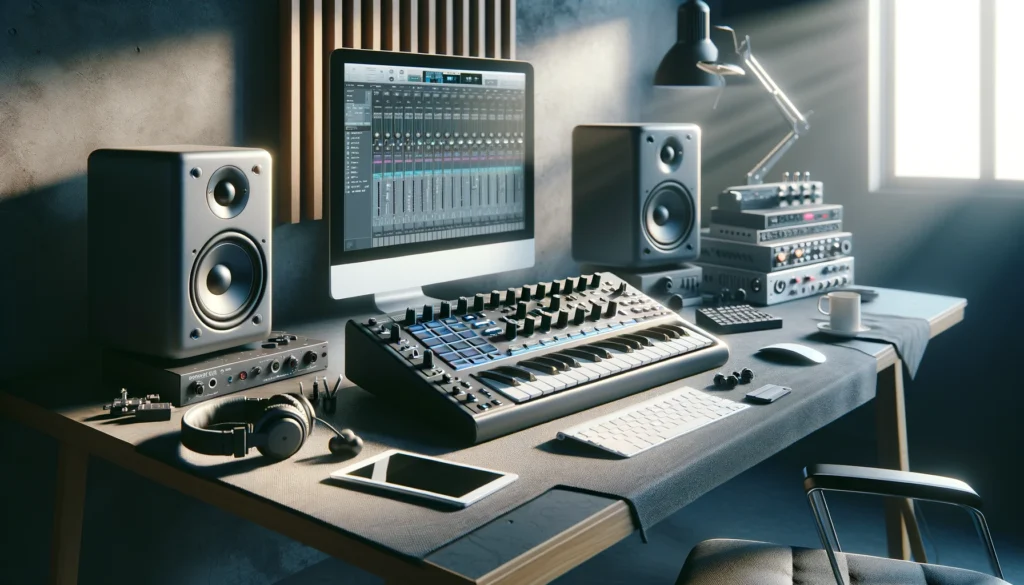Do you ever wonder how MIDI controllers can manipulate complex software instrument sounds without speakers of their own.
MIDI controllers are designed strictly for sending performance data rather than producing audio directly, instead relying on external sound modules and monitoring equipment to handle these duties.
Let’s dive in to understand more about how MIDI controllers differ from traditional instruments when it comes to sound production and monitoring capabilities.
Do MIDI Controllers Physically Contain Speaker Components?

MIDI controllers do not actually contain or require built-in speakers. They send digital data rather than produce audio directly.
We’ll explore monitoring options and other MIDI controller benefits more below.
What Is A MIDI Controller?

A MIDI controller is an electronic music device that allows performers and producers to transmit MIDI performance data or control signals to external sound modules or computer software.
MIDI stands for Musical Instrument Digital Interface.
This is a technical standard protocol that was established in 1982 and enables electronic instruments, controllers, computers, and other hardware to connect together and communicate digitally.
The main purpose of a MIDI controller is to function as a human interface to trigger and control MIDI sounds and performance data from an external sound source.
For example, when you press down a key on a MIDI keyboard controller, this sends MIDI note-on/note-off messages with pitch and velocity information to a hardware synth module or software plugin instrument on a computer.
The MIDI data gets converted into audio that makes the resulting sounds.
Unlike a typical electronic keyboard workstation, MIDI controllers do not generate or produce sound directly themselves.
They act as a separate control surface focused entirely on transmitting MIDI information in order to play and shape the sounds on the receiving end of the MIDI chain instead.
This allows performers to manipulate external MIDI gear that contains its own sounds, audio engines, and speaker components rather than having self-contained sounds within the MIDI controller itself.
Do MIDI Controllers Have Built In Speakers?

Because the main functionality of a MIDI controller involves transmitting digital control messages through ports and cables rather than actual audio signals, they do not feature or require built-in speakers.
MIDI data is communicated as code that relays precise performance instructions rather than containing any raw sound wave information.
The role of the MIDI controller is to send control and modulation messages like which notes are played, keyboard dynamics, knob adjustments, button presses, fader/slider movements, or controller feedback.
This MIDI information gets interpreted and converted into sound by a receiving external MIDI instrument, sound module, computer software instrument, or hardware synth module on the other end.
The receiving MIDI device handles taking the MIDI performance instructions and actually rendering the audio output through its own sound engine and components.
This receiving instrument would output its generated audio through outputs into an amp, PA system, speakers, headphones or an audio interface with studio monitors to be heard.
So in summary, MIDI controllers strictly focus on the job of sending MIDI performance control messages.
They do not feature or require built-in speakers, sound rendering engines, or audio components since they do not produce any actual sound themselves.
The MIDI performance instructions sent from the controller allow MIDI-compatible synthesizers, samplers, virtual instruments, and other audio devices down the chain to create the actual audio output.
Alternatives For Audio With MIDI Controllers

Given that MIDI controllers do not have built-in speakers to generate their own audio directly, there are a couple common options to handle monitoring the audio resulting from your MIDI controller performances:
Connecting To External Keyboard Amplifiers Or Powered Speakers
One alternative is to connect the audio outputs of your external MIDI synthesizer module or hardware instrument to a keyboard amplifier rig and speaker system.
For example, if you are using a MIDI keyboard controller to play an external hardware synth module, running 1/4″ audio cables from the synth module into a keyboard amplifier setup allows amplification and projection of the synth audio for live performance or stage monitoring.
Utilizing Computer Speakers, Headphones, or Other Playback Systems
If your MIDI controller is sending data to softsynths, virtual instruments, or Digital Audio Workstation plugins on your laptop or computer, you can listen to the rendered audio results through the computer’s own speakers, studio monitor speakers, or headphones.
The computer’s audio interface handles the translation of the synth plugin’s digital audio into analog signals that can be amplified through speakers or headphones.
Routing Into An Audio Interface With Monitor Outputs
Higher-end external audio interfaces aimed at music production often include 1/4″ or XLR outputs designed for studio monitor speakers.
You can connect the audio outputs from MIDI synthesizers, drum machines or other MIDI hardware instruments into these inputs on the audio interface.
This allows flexible monitoring directly through the interface software’s volume, routing, and mixing capabilities.
MIDI Sound Module or Keyboard Amp With Speakers
Some all-in-one MIDI keyboard synths and sound modules also feature built-in amplification, mixing capabilities, and speakers for a self-contained direct monitoring solution.
If using a keyboard amp with speakers, routing MIDI instruments through these can provide monitoring without requiring an external computer or audio interface setup.
Other Benefits Of Using MIDI Controller Setups

Utilizing separate MIDI controllers instead of all-in-one keyboard workstations provides some additional benefits:
Focus On Expressive Playing Without Needing Onboard Sounds
Since the MIDI controller does not use processing power for sound generation, it can focus specifically on being a responsive, expressive instrument for shaping performances.
Without needing speakers or its own synth engine, it omits costs from audio components and instead dedicates resources exclusively for dynamic playing control of external sound sources.
Route MIDI Data To Control Multiple Instruments
The MIDI protocol allows daisy chaining connections of up to 16 devices using MIDI cables or chaining USB hubs.
This makes it simple to route the MIDI control messages from one central controller keyboard or surface to multiple hardware synthesizers, software plugins, drum machines, samplers, and more to control a dynamic array of different sounds from a central point.
Customize Your Own Sound Library Using Plugins/Synths
Using a MIDI controller to trigger softsynths and VST plugins on a music production computer allows endless customization options.
You can continually purchase, download, and experiment with new synth plugins to constantly evolve your own personalized software instrument sound library.
This level of flexibility is not as readily available on an all-in-one keyboard workstation device.
Utilize MIDI Mapping To Control Parameters
MIDI mapping allows assigning MIDI continuous controllers, sliders, mod wheels, and other controls on a MIDI controller surface to manipulate software instrument parameters.
This unlocks powerful shaping options for fine tuning multiple parameters like filters, envelopes, effects, and more during performances.
Conclusion
While MIDI music controllers do not actually feature or require internal speakers, they excel at transmitting digital MIDI performance data to shape the sounds of MIDI-compatible instruments, computer software synths, hardware sound modules, and more devices down the sound generation chain.
There are ample equipment options such as external amps, audio interfaces, headphones and playback systems to handle monitoring the audio results when using MIDI controllers.
The separation of the MIDI controller from built-in sound sources or speakers allows for very responsive, focused playing surfaces.
This inspires dynamic performances, greater portability, and flexibility in routing MIDI data to an array of gear for customizing your own software synth sounds.
By understanding the difference between the performance instruction data role of MIDI controllers vs sound generating duties of MIDI instruments, you can craft the perfect MIDI ecosystem suitable for your music production needs.
